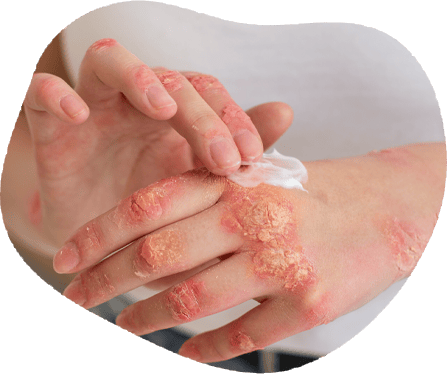Skin is of utmost importance in the human system. It is necessary to protect the skin from negative factors. Skin disease treatment involves considering your skin type, identifying your skin trigger points, considering some external environmental factors, and making some changes to your eating habits and lifestyle. Doing this can help you manage your skin disorder. It's clear why we pay close attention to the skin, its health, functions and appearance. But if any disease is treated at the right time, the disease stops progressing, and the days become worry-free. The most important thing is to identify the disease and get the best treatment by examining its symptoms.
Book Appoinment
Types of Skin Diseases
Many skin diseases include vitiligo, psoriasis, atopic dermatitis, lipoma, acne, ichthyosis, epidermolysis bullosa, alopecia areata, etc. Due to this, patients have to face a lot of problems. These are like this
It is an autoimmune skin condition in which skin colour is lost, resulting in milky white patches on the skin. These are the early stages of vitiligo. The immune system mistakenly targets and destroys melanocytes—cells that produce pigment—causing vitiligo. It is more common in individuals with darker skin. Some people may also experience eye irritation or swelling and loss of hearing ability.
Signs and symptoms of vitiligo:
- Initially, these spots appear light grey.
- New patches start spreading in different places.
- The borders of the white spots appear to expand.
- It commonly affects the hands, feet, elbows, knees, face, and genitals.
It is a chronic (long-term) autoimmune skin condition that affects millions of people worldwide. Although its exact cause is still under investigation, it is clear that genetic and environmental factors play essential roles in its development. The cause of psoriasis disease is thick, scaly areas that appear on the surface of the skin. Due to psoriasis, the patient has to face many problems.
Symptoms of Psoriasis:
- Itching, burning, or pain
- Spots of dandruff-like scaling
- Dry, cracked skin that may bleed
- Small scaling spots (usually seen in children)
Your hair follicles clog with dead skin cells and oil, leading to acne, a skin disorder. It results in pimples, blackheads, or whiteheads. Although it affects people of all ages, teenagers are most commonly affected by acne.
What are the symptoms of acne:
- Pimples
- Small red, tender bumps
- Large, solid, painful lumps under the skin.
- Painful, pus-filled lumps under the skin.
It is a lump of fatty tissue that grows just beneath the skin. It moves easily when touched and feels rubbery, not hard. Most lipomas are not painful and can appear anywhere on the body, but they are most common on the back, torso, arms, shoulders, and neck.
Symptoms of lipoma:
- It can be larger and wider than 6 inches.
- There are fatty lumps of symmetrical rubbery tissue.
- They are located just below the skin's surface and move when touched.
- Discomfort depends on its location, size, and presence of blood vessels.
It is also known as eczema and is a chronic (long-lasting) skin condition that causes irritation, rashes, and swelling. This is a normal situation. This skin disorder can happen to anyone at any age. Atopic dermatitis is not contagious and cannot spread from one person to another.
Symptoms of atopic dermatitis:
- Skin thickening
- Formation of crust on the skin.
- Darkening of the skin around the eyes.
- Small, raised bumps on brown or black skin.
Types of Skin Treatments
There are different types of skin disease treatments available in the world, such as (chemical skin peels, microdermabrasion, mesotherapy, needle-free mesotherapy, microneedling, dermaplaning, LED-low-level light therapy, radiofrequency, microblading and laser hair removal). The method of treatment is different for everyone. However, there is no guarantee that all of these treatments will not have side effects. Let's talk about the best skin disease treatment.
